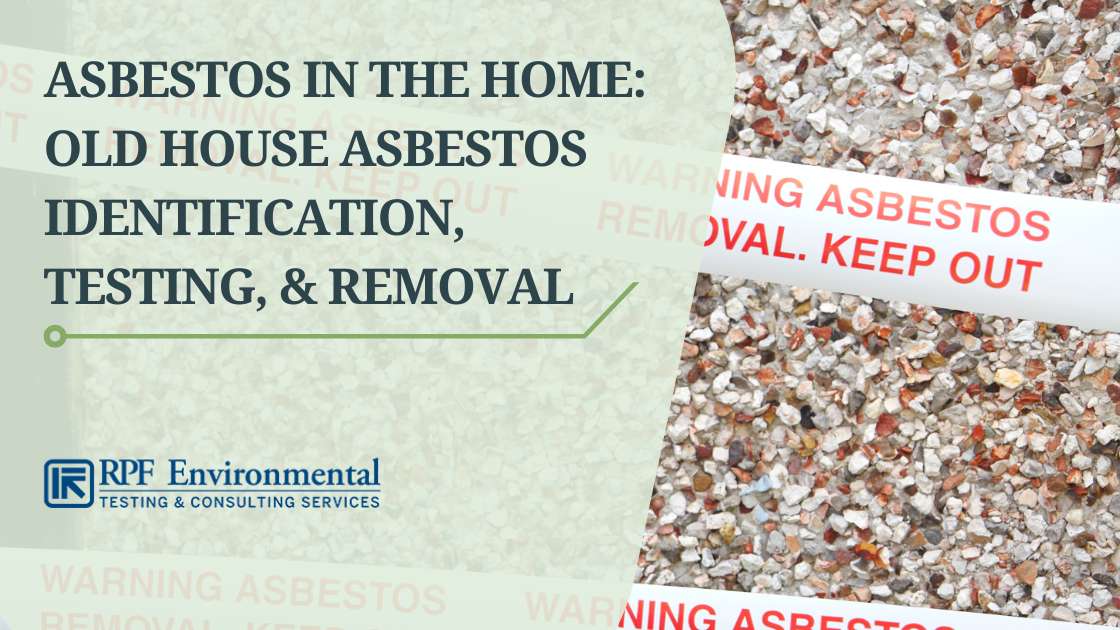Asbestos in old houses, especially those built from the 1920s to the 1970s, can be found in walls, floors, insulation, pipes, ceilings, and others. Once airborne fibers are inhaled or ingested when disturbed during house remodeling, they can lead to deadly diseases that are often diagnosed 10-50+ years after exposure.
It cannot be detected through smell or visual inspection alone, but there are signs that may indicate that your home has asbestos. Only professional testing and abatement can accurately detect and completely remove asbestos in your home to protect your family from further exposure. Keep on reading to learn more about identifying, testing, and removing asbestos in your home including other important information you need to know such as its health risks.

RPF Environmental’s licensed and experienced professionals can help you test for asbestos in your home accurately to ensure the safety of your family and protect your investment before buying or remodeling an old house. We serve the entire nation, including Illinois, Indiana, Maine, Massachusetts, and New Hampshire. Contact us now!
What Is Asbestos and Why Should You Worry?
Asbestos refers to a group of natural mineral fibers that can only be seen through a microscope. Due to its fire resistance and thermal properties, it was used in various building materials for enhanced strength and durability. However, it has been classified as a human carcinogen by EPA, IARC, and HHS. When asbestos-containing materials (ACMs) are disturbed and damaged, they will release hazardous fibers into the air that can be ingested or inhaled by anyone unknowingly.
Old House Asbestos Identification Guide: How Do You Know if Asbestos Is in Your House or Basement?
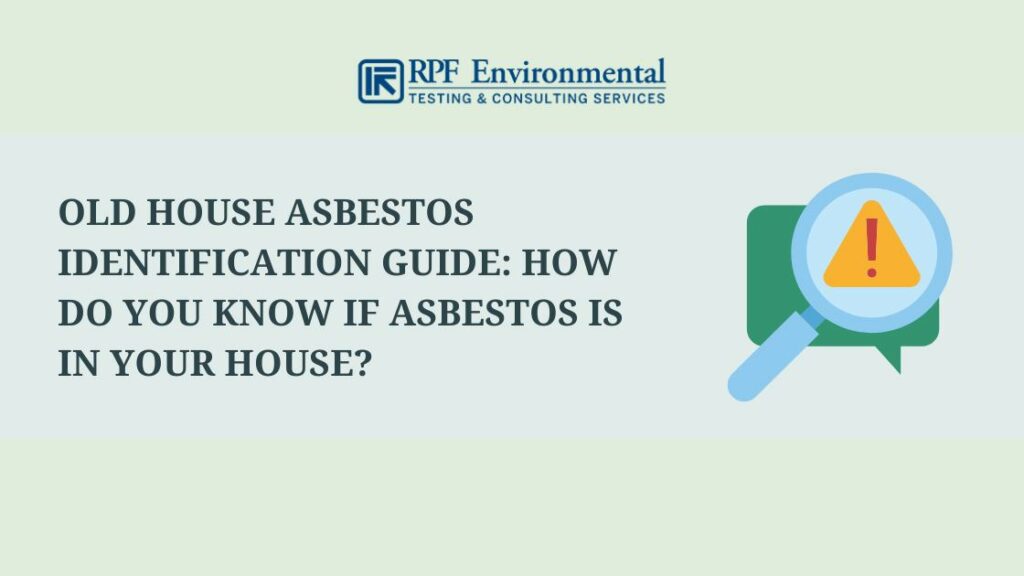
You can’t accurately identify asbestos once it becomes part of a product, but below are some ways you can tell if your house might contain asbestos:
Method 1. Identifying the Age of the House: How Old Does a House Have to Be to Have Asbestos?
If your home was built or renovated before the 1980s, it is more likely to contain asbestos materials. Asbestos products were manufactured as early as the 1920s and were extensively used from the 1930s to the 1970s. However, homes built from the 1980s to the 1990s are not guaranteed to be completely free from asbestos. The risk is just lower.
NOTE: Aside from old houses, many public buildings like schools, commercial buildings, and government housing built prior to the 1980s may also contain asbestos.
Method 2. Signs to Tell if a Material in Your Home Contains Asbestos
The basic signs that an old home might contain asbestos include having the following materials:
- Vinyl flooring
- Popcorn ceilings
- Corrugated roofing
- Vermiculite insulation
- Cement sheet walls
Visual Identification: What Does Asbestos Look Like?
Natural asbestos can appear brown, blue, white, or green. But once it is processed with building materials, it will look similar to nonasbestos-containing products and visual identification won’t be accurate. However, you may be able to see fluffy or fuzzy fibers once the material is damaged. Other signs you can look for are:
1. Signs of Wear & Water Damage
Look for signs of water damage, abrasions, and tears but be careful not to disturb and touch the material to avoid releasing toxic fibers into the air. We recommend checking suspected materials regularly to prevent exposure.
2. Dimpling of Construction Materials
Asbestos can also cause dimpling in the surface of specific products like pipe insulation, roofing, and shingles.
3. Check for Labels (e.g. Brands) in the Material
One sure way to determine if materials contain asbestos is if they are labeled. For instance, you will usually find labels on the back of vinyl tiles. You may see the manufacturing date, an “asbestos containing” label, and the manufacturer or brand. Manufacturing dates from the 1920s to the 1970s mean the material is most likely to contain asbestos. Also, there are companies that manufactured ACMs like American Olean Tile, Armstrong International, United States Gypsum, and others.
Expert Tips
- If you notice any sign of asbestos, especially if the material is starting to deteriorate or is damaged, have it sampled and tested by a licensed professional.
- If you’re in doubt, it is always wise to assume that any material installed before the 1980s contains asbestos and you should treat it with caution.
Method 3. Searching for Asbestos Hazards: Where Would Asbestos Be in an Old House?
Old houses may have asbestos in various household materials such as:
- Roofing shingles and felt
- Siding shingles
- Popcorn ceilings
- Vermiculite attic and wall insulation
- Hot water, steam pipe, HVAC duct, boiler, and furnace duct insulation
- Textured paint
- Sheetrock walls
- Joint and patching compounds for ceilings and walls
- Vinyl tiles, vinyl sheet flooring, and adhesives
- Some linoleum flooring
- Cement sheets
- Millboard and paper insulation
- Door gaskets in furnaces and stoves
- Window glazing and caulking
- Other old household products like stove-top pads, fireproof gloves, ironing board covers, etc.
Asbestos in Basements
Moreover, it is also common to find asbestos in the basement. Since basements are often overlooked when doing house renovations and repairs, there is a high chance that your basement may have asbestos especially if the house is old.
Among the common asbestos materials that can be found in basements include the following:
- Pipe and ductwork coverings including insulation sleeves, tapes, adhesives, and bonding agents that were used to withstand extreme temperatures in the basement
- Asbestos-contaminated cement floors that are common in basements along with vinyl sheet (linoleum) flooring, vinyl tiles, and adhesives used
- Carpet, floor tile, and coving mastic
- Vapor barriers, soundproofing, and ceiling panels
- Some types of paint
NOTE: While restrictions have been put on most residential uses for asbestos to protect the public from exposure, it is still not completely banned.
Method 4. Hire a Licensed Asbestos Inspector for Accurate Identification
Visual clues help determine the potential presence of asbestos in your home, but only professional testing can accurately identify asbestos. A complete assessment will be done where the materials will be sampled and tested in a laboratory. Asbestos professionals are properly equipped and trained to handle asbestos. We’ll discuss more about hiring asbestos professionals later.
Also Read: Do Home Inspections Check for Asbestos?
What to Know About DIY Asbestos Test Kits
You can use DIY test kits to scrape off samples yourself if it is legal in your area and send them for testing to an accredited laboratory. However, testing requires disturbing the material which can cause asbestos fibers to become airborne and can put your family at risk. Thus, we don’t recommend taking samples yourself. But if you insist on doing it, make sure to follow safety precautions and that you have enough knowledge on how to properly handle asbestos materials to avoid violations.
Health Risks of Asbestos in Old Houses & Basements: Is Asbestos in Your House Dangerous?
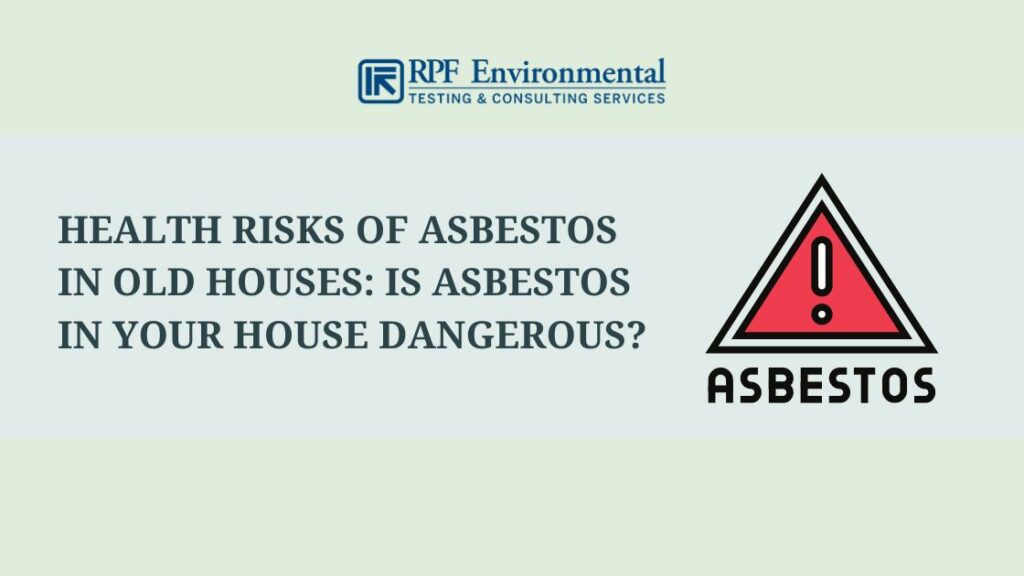
Asbestos fibers are microscopic and can be easily inhaled. Once they enter your lungs, they will cause irreversible damage and increase your risk of developing cancer diseases.
Health Problems That Asbestos Can Cause
Prolonged exposure to asbestos can lead to the following diseases:
- Asbestosis
- Mesothelioma
- Lung cancer
- Laryngeal cancer
- Pleural effusion
- Ovarian cancer
- Pleural thickening
- Pleural plaques
In addition, asbestos exposure can cause various symptoms including:
- Shortness of breath
- Coughing up blood
- Difficulty in swallowing
- Chest or abdomen pain
- Chronic cough
- Wheezing
- Face or neck swelling
- Weight loss
- Fatigue
- Loss of appetite
How Much Asbestos Exposure Is Harmful?
There is no “safe” level of asbestos exposure for any type of asbestos fiber. Asbestos exposures as short in duration as a few days have caused mesothelioma in humans. – Occupational Safety and Health Administration (OSHA)
Most asbestos diseases were caused by occupational exposure where the workers were repeatedly exposed to ACMs and might have ingested or inhaled large amounts of asbestos. This means that it is unlikely for homeowners to develop asbestos diseases. However, take note that asbestos exposure is cumulative. Once you inhale asbestos, the fibers can remain in your lungs for a long time which increases your risk of developing asbestos diseases even at low doses. In addition, the risk becomes even greater if you have a history of smoking.
When Is Asbestos in a Home Dangerous?
Living with asbestos materials in your home is not usually a serious problem if they are still in good condition because they won’t release airborne asbestos fibers. The danger comes from damaged asbestos caused by disturbance or deterioration either by:
- Hitting
- Sawing
- Scraping
- Sanding
- Drilling
- Cutting
- Extreme vibration
- Air flow
- Flooding
- Water damage
- Fire & other natural disasters
NOTE: Disturbing asbestos materials in good condition will create a hazard where none existed before. Better leave them alone.
Examples of Where Asbestos Exposure Happens
Specific examples of scenarios that will cause asbestos exposure are activities during a DIY renovation or remodeling which include the following:
1. Replacing Attic Insulation
One of the popular sources of asbestos exposure was vermiculite insulation in attics. This insulation is a pebble-like material that is common in attic floors and was often sold under the brand Zonolite.
2. Tearing Out Floor Tiles
Asbestos was commonly used in vinyl tiles and vinyl sheets along with adhesives in other flooring materials. Tearing your old kitchen or bathroom floor out, scraping, and sanding them to install new flooring can release asbestos into the air.
3. Knocking Down Asbestos-Contaminated Walls
Asbestos in walls can be found in the form of drywalls (also called sheetrock or gypsum board). Asbestos-containing decorative materials may have also been sprayed on the walls. Aside from knocking down your walls and cutting them, drilling into them to install wall decorations can also cause asbestos fibers to become airborne.
4. Fixing Plumbing Systems
Wrapped asbestos insulation was popularly used to cover pipes, ducts, plumbing, and HVAC components. Thus, fixing older plumbing systems that involves cutting, tearing, and sawing the pipes will lead to asbestos exposure.
5. Removing Textured (Popcorn) Ceiling
Scraping off old paint in your ceiling to replace them will release microscopic fibers that can easily pass through your dust mask. Also known as acoustic, stucco, and stipple ceilings, textured ceilings often contain paint that was manufactured with high concentrations of asbestos for soundproofing.
6. Repairing Vehicles in Your Garage
Asbestos was also used in brakes and other car parts before the 1980s. You shouldn’t repair old vehicles in your garage.
What Should You Do if You Think You’ve Been Exposed to Asbestos in Your Home?
Seek medical attention if you think you’ve been exposed to asbestos. Medical professionals can perform screening tests like a CT scan and chest X-rays to detect asbestos diseases.
NOTE: Take note that most asbestos diseases are rarely curable and some are deadly. Diseases are also most often diagnosed 10 to 50 years after exposure when they’re already at their worst stages. We recommend hiring professional asbestos testing and abatement companies to prevent developing these diseases.
Hiring Professionals for Asbestos Testing & Abatement: What Should You Do If You Suspect Asbestos in Your Home or Basement?
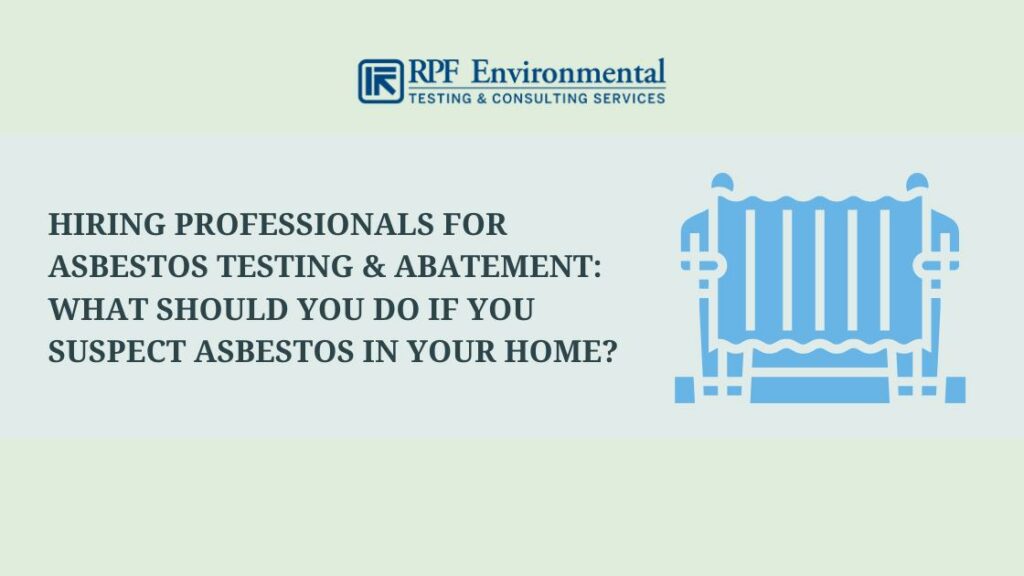
There’s no need to panic if you suspect asbestos in your home. Just leave the materials alone and let trained and certified asbestos professionals handle the testing and removal for you to ensure safety and compliance with asbestos laws.
Hiring Professional Inspectors for Home Asbestos Testing to Ensure Your Family’s Safety
Licensed asbestos inspectors, like RPF Environmental, can conduct a complete assessment of asbestos in your home as well as advise you about what to do next in case asbestos has been found. They can also check your home after repair or removal to make sure that asbestos exposure risks have been completely eliminated.
When Should You Have Your Home Tested for Asbestos?
- If the building materials are damaged or are crumbling (e.g. damaged insulation or drywall)
- If you are planning to renovate or remodel your home
- If you’ll be doing any activity that might disturb the materials
- If you are buying an old house
How Much Does Asbestos Testing Cost?
Asbestos testing and inspection can range from $200 to $1,000+ but the average is around $400+. The cost will depend on how many samples will be taken, the methodologies, and local asbestos laws. Comprehensive inspections will be more expensive and will include airborne asbestos testing, material sampling, and Asbestos Hazard Emergency Response Act (AHERA) inspection.
Hiring Corrective-Action Contractors for Asbestos Abatement in Old Houses
Removal is done when asbestos laws and regulations require it and is often the last option due to the high risk of releasing airborne fibers and the complexity of the task. It may also be required when ACMs have been extensively damaged or if you will be doing major remodeling in your home.
NOTE: Do not attempt DIY removal. Professionals have undergone special training for handling asbestos safely to minimize the risk of exposure during the process. They have the right permits and equipment for proper removal and disposal and are well-versed in asbestos laws and regulations to avoid costly penalties.
Encapsulation & Enclosure: Repairing as an Alternative to Asbestos Removal
When removal is not necessary, the asbestos materials can be sealed or covered which is a cheaper alternative.
1. Sealing
Also called encapsulation, sealing involves treating ACMs with a sealant that coats or binds the fibers together to prevent them from becoming airborne. Insulation in plumbing, pipes, furnace, and boiler can be encapsulated.
2. Covering
Also called enclosure, covering involves installing a protective wrap over the material like covering exposed asbestos insulation in pipes.
5 Tips for Removing & Repairing Asbestos Safely
- Make sure that the contractor follows safety protocols and has the right permits and equipment to do the job safely.
- We don’t recommend doing even minor repairs yourself because improper handling can easily release dangerous asbestos fibers into the air. If you insist on doing it, make sure that you have undergone proper training.
- Only stick to minor repairs even if you’ve completed a training program in your area.
- Request asbestos testing after the removal process before the contractor removes their containment system.
- You can discard damaged stove-top pads, fireproof gloves, or ironing board covers yourself. But, make sure to contact involved local agencies in your area about proper handling and disposal procedures.
3 Helpful Tips for Hiring Asbestos Inspectors and Contractors
- Only hire licensed, trained, and experienced asbestos professionals. (e.g EPA-approved and certified to perform asbestos testing or removal in your area)
- Hire an asbestos testing firm that is not connected with any abatement company to ensure that there is no conflict of interest. Always work with two separate firms.
- Check with your local agencies to confirm that the company has no safety violations before hiring them.
You can read more about hiring asbestos professionals by EPA here.
Also Read: Asbestos Cost: How Much Is Asbestos Testing and Removal?
Other Important Things You Might Want to Know About Asbestos in Homes
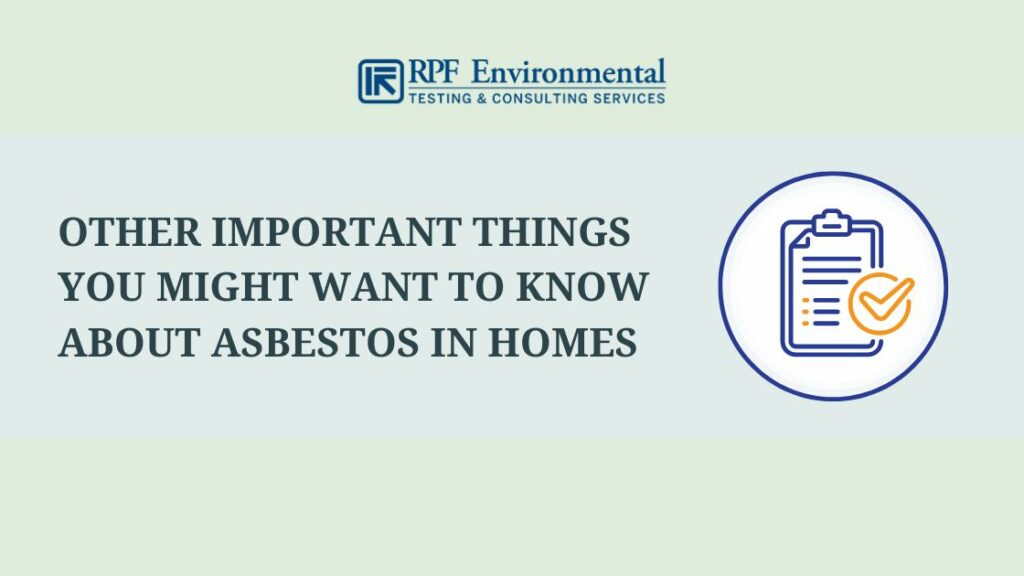
Below are other important information that you might want to know about asbestos:
Laws & Regulations for Protecting Homeowners From Asbestos Exposure
The EPA has put up various laws and regulations that aim to protect the public from asbestos exposure including the following:
- Asbestos Hazard Emergency Response Act (AHERA)
- Asbestos National Emission Standard for Hazardous Air Pollutants (NESHAP)
Dos And Don’ts For The Homeowner to Prevent Asbestos Exposure
If you have an old house or are buying one, take note of these dos and don’ts:
Dos
- Avoid contact with materials that you suspect contain asbestos, especially damaged ones. You should also limit access to the area and keep your activities to a minimum to avoid disturbing the materials.
- Always test for asbestos in your house before doing any remodeling project.
- If you’re buying a house, it is wise to ask the seller about the presence of potentially hazardous materials in the house like asbestos or lead.
- Leave asbestos repairs and removal to the professionals, even minor ones.
- Always contact applicable regulatory agencies in your area before doing any demolition.
Don’ts
- Don’t saw, scrape, drill, sand, or cut suspected asbestos materials.
- Don’t vacuum or sweep debris from asbestos materials.
- Don’t use power strippers or abrasive pads on asbestos flooring.
- Don’t collect samples yourself if you’re unsure how to do it properly.
- Don’t dispose of ACMs with regular household waste.
What Happens Once You Violate Asbestos Regulations?
There are strict regulations that must be followed when testing or removing asbestos-containing products in old homes. Violating them can lead to costly penalties and criminal charges as well as prison time depending on how severe the violation is.
Can You Sell a House With Asbestos?
Yes, because there are no federal laws requiring sellers to tell buyers about the presence of asbestos in the house. But, some states do require sellers to disclose this information.
How Do You Remove Asbestos From the Air of an Old House?
HEPA air purifiers can be used to filter at least 99.97% of microscopic contaminants in the air including asbestos fibers depending on the quality of the product. However, they are only limited to cleaning the air in the room where they are stationed. Also, you can’t completely eliminate airborne asbestos fibers unless the source is dealt with.
FAQs
Yes, there is a high chance that it might contain asbestos. Asbestos was known to be used in house construction as early as the 1920s mainly in the form of plaster as well as asbestos cement roofing and siding.
Houses built from the 1930s up to the 1950s are more likely to contain asbestos insulation, textured paint, and patching compounds on ceilings and walls. This was the time when the use of asbestos was popular in almost every building material due to its durability and fire resistance.
Places where you can find asbestos in old houses are in basements, walls, ceilings, flooring, roofing, attic, and plumbing insulation.
Conclusion
Always assume that old houses contain asbestos if they were built between 1920 to 1980 and you should request for asbestos testing before doing any major remodeling project. Also, never attempt collecting samples and doing even minor repairs or removal yourself to avoid creating health risks where none existed before. We recommend hiring professional asbestos inspectors and abatement contractors to guarantee safety and prevent penalties.
RPF Environmental is a certified environmental consulting company that provides professional asbestos testing and inspection across the United States including Maine, Massachusetts, and New Hampshire. Book an appointment now!

